Energy Saving and Replacing Costly Resources Analysis Report
VerifiedAdded on 2023/04/19
|8
|1295
|367
Report
AI Summary
This report delves into energy-saving strategies and resource replacement, focusing on the Department of Emissions and Climate Change (DECC) and its building management system (BMS) applications. It examines the DECC's initiatives at 3 Whitehall Place, analyzing their impact on energy efficiency, carbon emissions reduction, and cost savings. The case study reveals significant reductions in gas and electricity consumption, even with an increase in staff, highlighting the economic, social, and environmental benefits. The report discusses the implementation of energy-efficient technologies, such as pre-cooling techniques, and provides recommendations for further improvements, including the use of more energy-efficient lighting and optimized temperature control, ultimately aiming for a sustainable and cost-effective energy management approach.
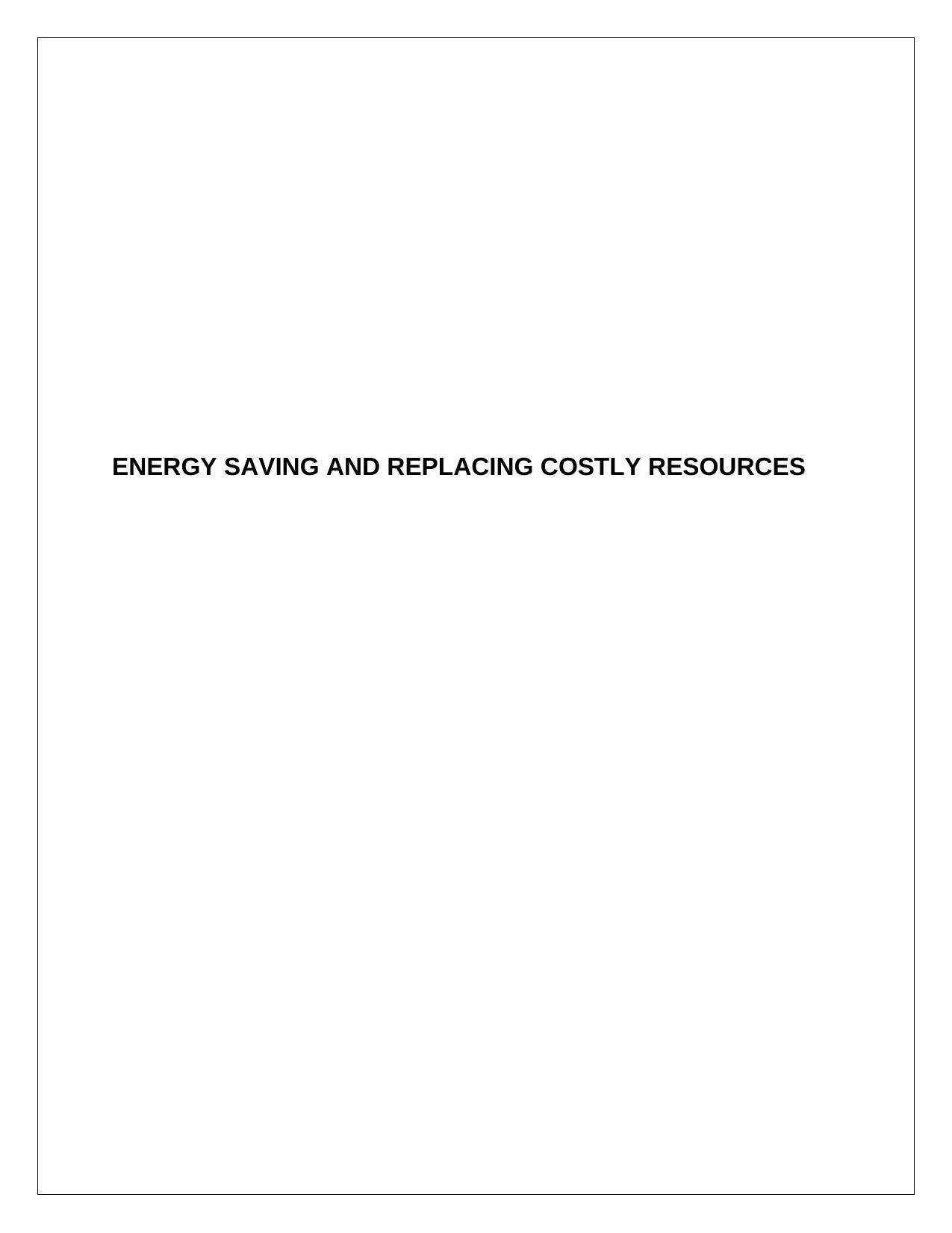
ENERGY SAVING AND REPLACING COSTLY RESOURCES
Paraphrase This Document
Need a fresh take? Get an instant paraphrase of this document with our AI Paraphraser
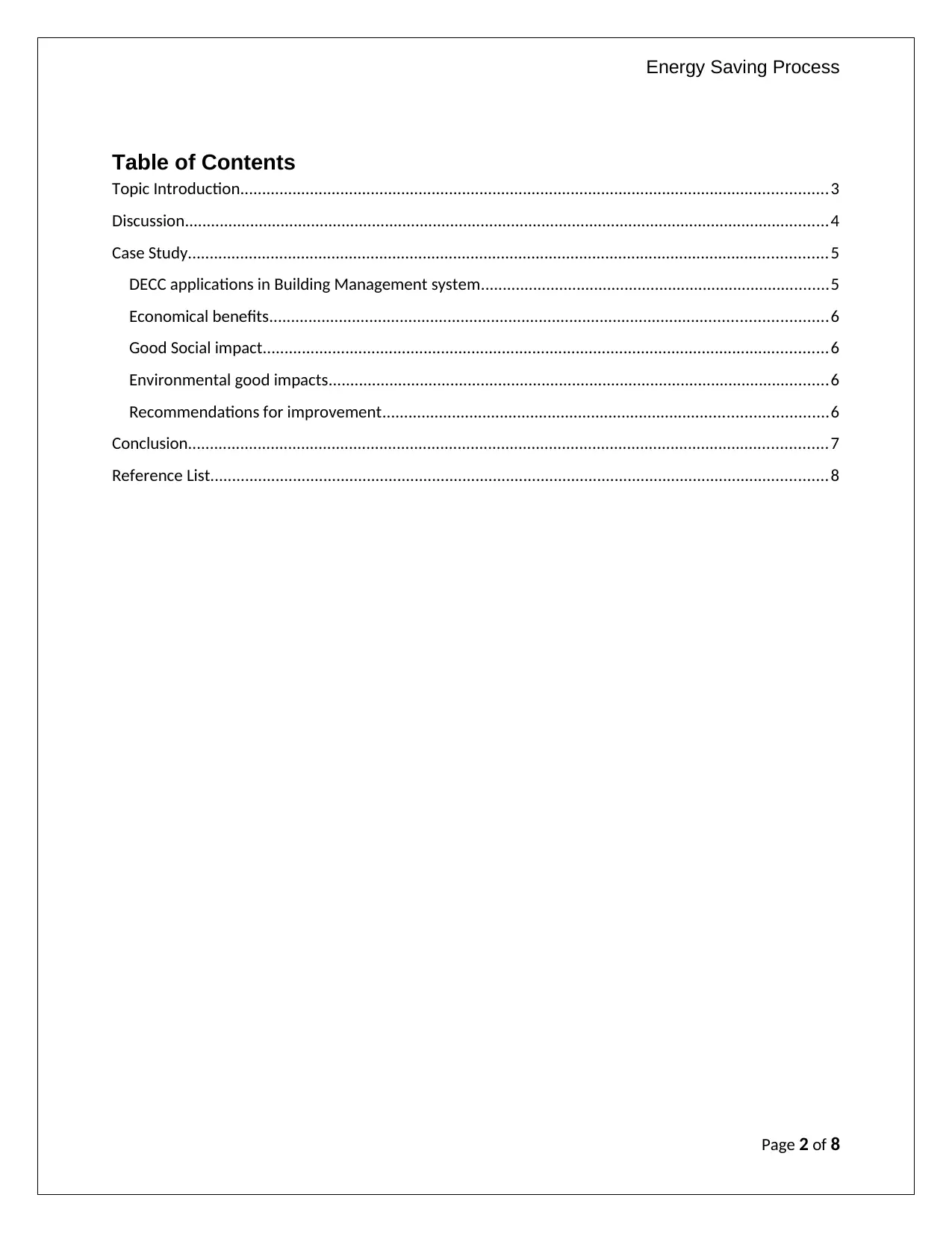
Energy Saving Process
Table of Contents
Topic Introduction.......................................................................................................................................3
Discussion....................................................................................................................................................4
Case Study...................................................................................................................................................5
DECC applications in Building Management system................................................................................5
Economical benefits................................................................................................................................6
Good Social impact..................................................................................................................................6
Environmental good impacts...................................................................................................................6
Recommendations for improvement......................................................................................................6
Conclusion...................................................................................................................................................7
Reference List..............................................................................................................................................8
Page 2 of 8
Table of Contents
Topic Introduction.......................................................................................................................................3
Discussion....................................................................................................................................................4
Case Study...................................................................................................................................................5
DECC applications in Building Management system................................................................................5
Economical benefits................................................................................................................................6
Good Social impact..................................................................................................................................6
Environmental good impacts...................................................................................................................6
Recommendations for improvement......................................................................................................6
Conclusion...................................................................................................................................................7
Reference List..............................................................................................................................................8
Page 2 of 8
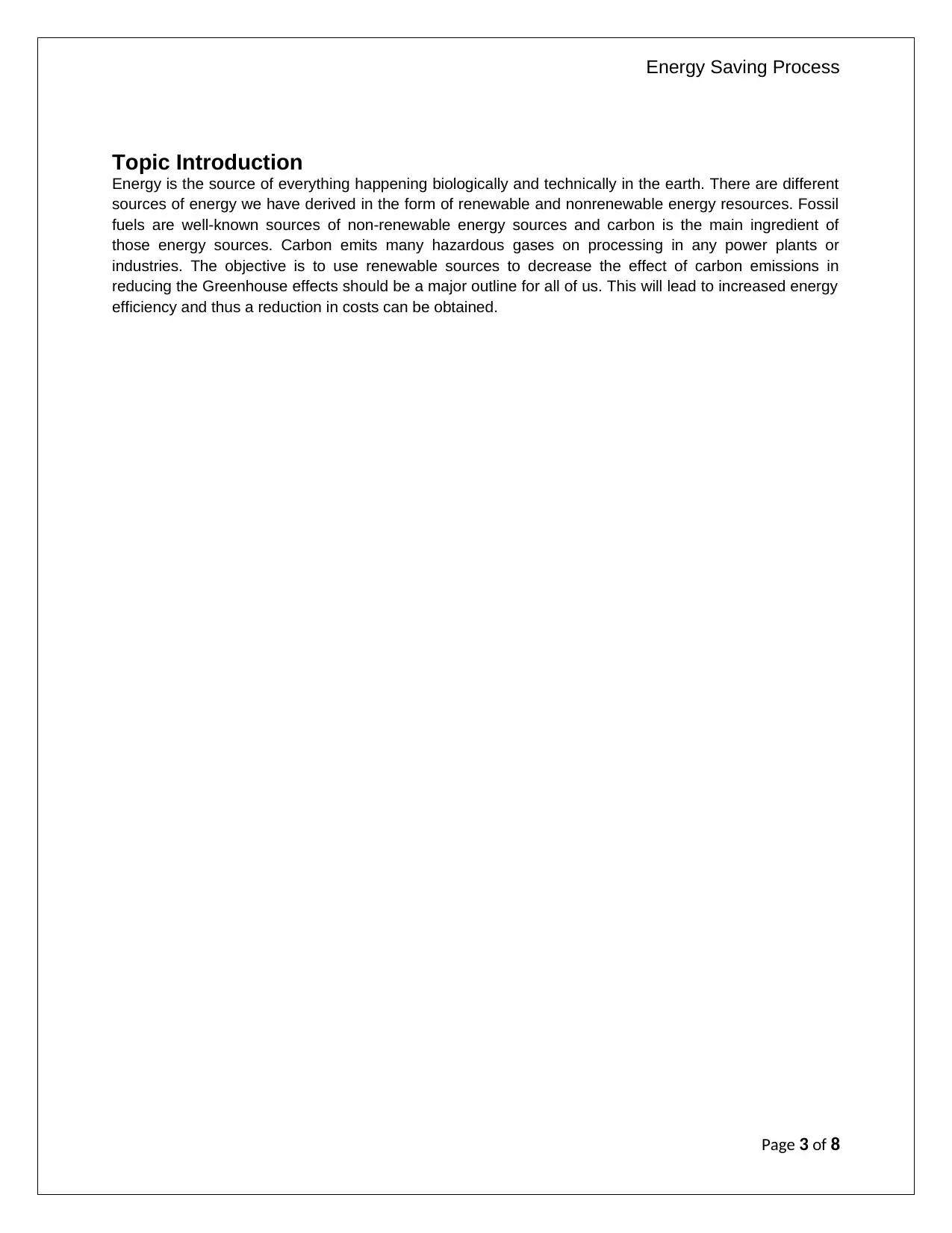
Energy Saving Process
Topic Introduction
Energy is the source of everything happening biologically and technically in the earth. There are different
sources of energy we have derived in the form of renewable and nonrenewable energy resources. Fossil
fuels are well-known sources of non-renewable energy sources and carbon is the main ingredient of
those energy sources. Carbon emits many hazardous gases on processing in any power plants or
industries. The objective is to use renewable sources to decrease the effect of carbon emissions in
reducing the Greenhouse effects should be a major outline for all of us. This will lead to increased energy
efficiency and thus a reduction in costs can be obtained.
Page 3 of 8
Topic Introduction
Energy is the source of everything happening biologically and technically in the earth. There are different
sources of energy we have derived in the form of renewable and nonrenewable energy resources. Fossil
fuels are well-known sources of non-renewable energy sources and carbon is the main ingredient of
those energy sources. Carbon emits many hazardous gases on processing in any power plants or
industries. The objective is to use renewable sources to decrease the effect of carbon emissions in
reducing the Greenhouse effects should be a major outline for all of us. This will lead to increased energy
efficiency and thus a reduction in costs can be obtained.
Page 3 of 8
⊘ This is a preview!⊘
Do you want full access?
Subscribe today to unlock all pages.

Trusted by 1+ million students worldwide
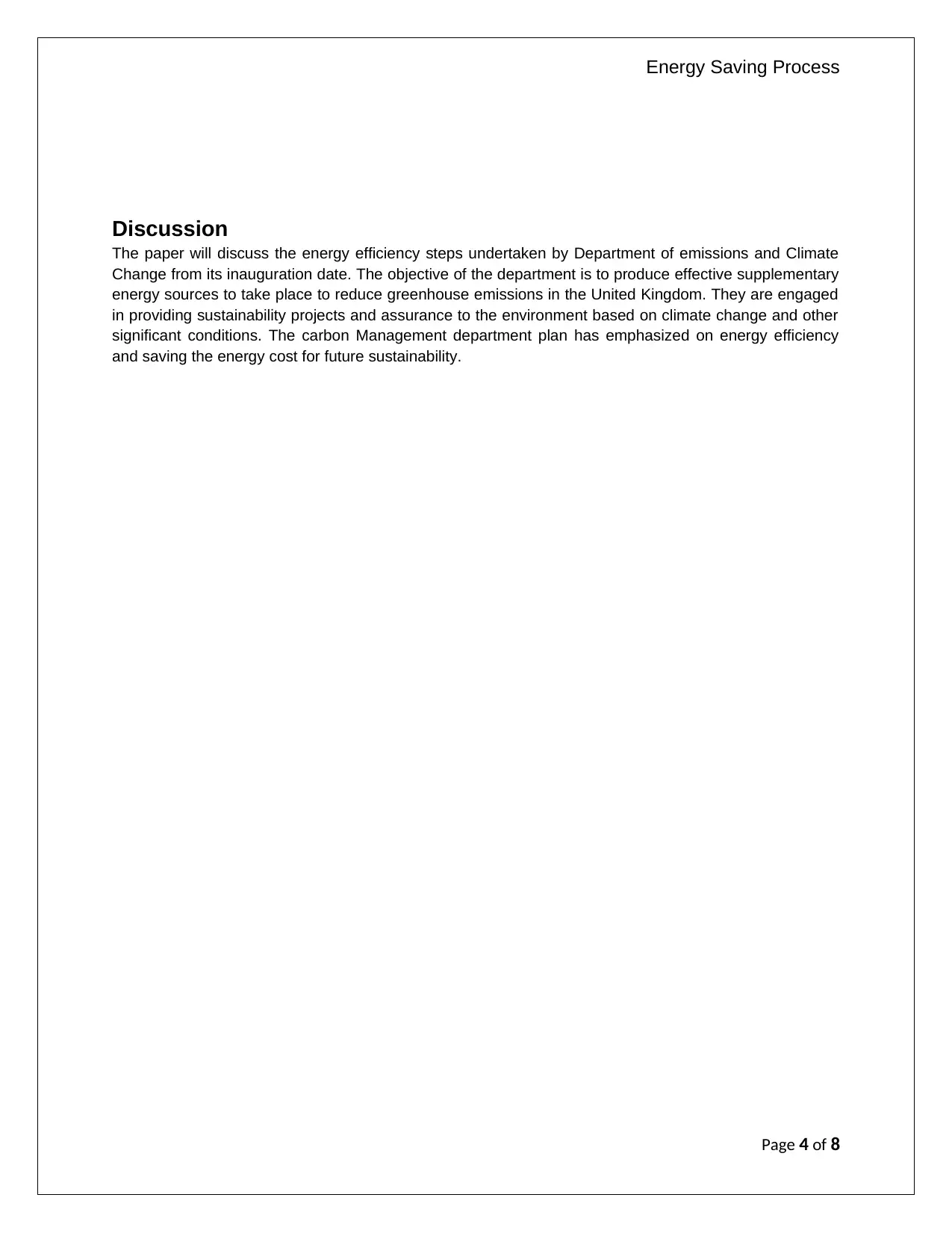
Energy Saving Process
Discussion
The paper will discuss the energy efficiency steps undertaken by Department of emissions and Climate
Change from its inauguration date. The objective of the department is to produce effective supplementary
energy sources to take place to reduce greenhouse emissions in the United Kingdom. They are engaged
in providing sustainability projects and assurance to the environment based on climate change and other
significant conditions. The carbon Management department plan has emphasized on energy efficiency
and saving the energy cost for future sustainability.
Page 4 of 8
Discussion
The paper will discuss the energy efficiency steps undertaken by Department of emissions and Climate
Change from its inauguration date. The objective of the department is to produce effective supplementary
energy sources to take place to reduce greenhouse emissions in the United Kingdom. They are engaged
in providing sustainability projects and assurance to the environment based on climate change and other
significant conditions. The carbon Management department plan has emphasized on energy efficiency
and saving the energy cost for future sustainability.
Page 4 of 8
Paraphrase This Document
Need a fresh take? Get an instant paraphrase of this document with our AI Paraphraser
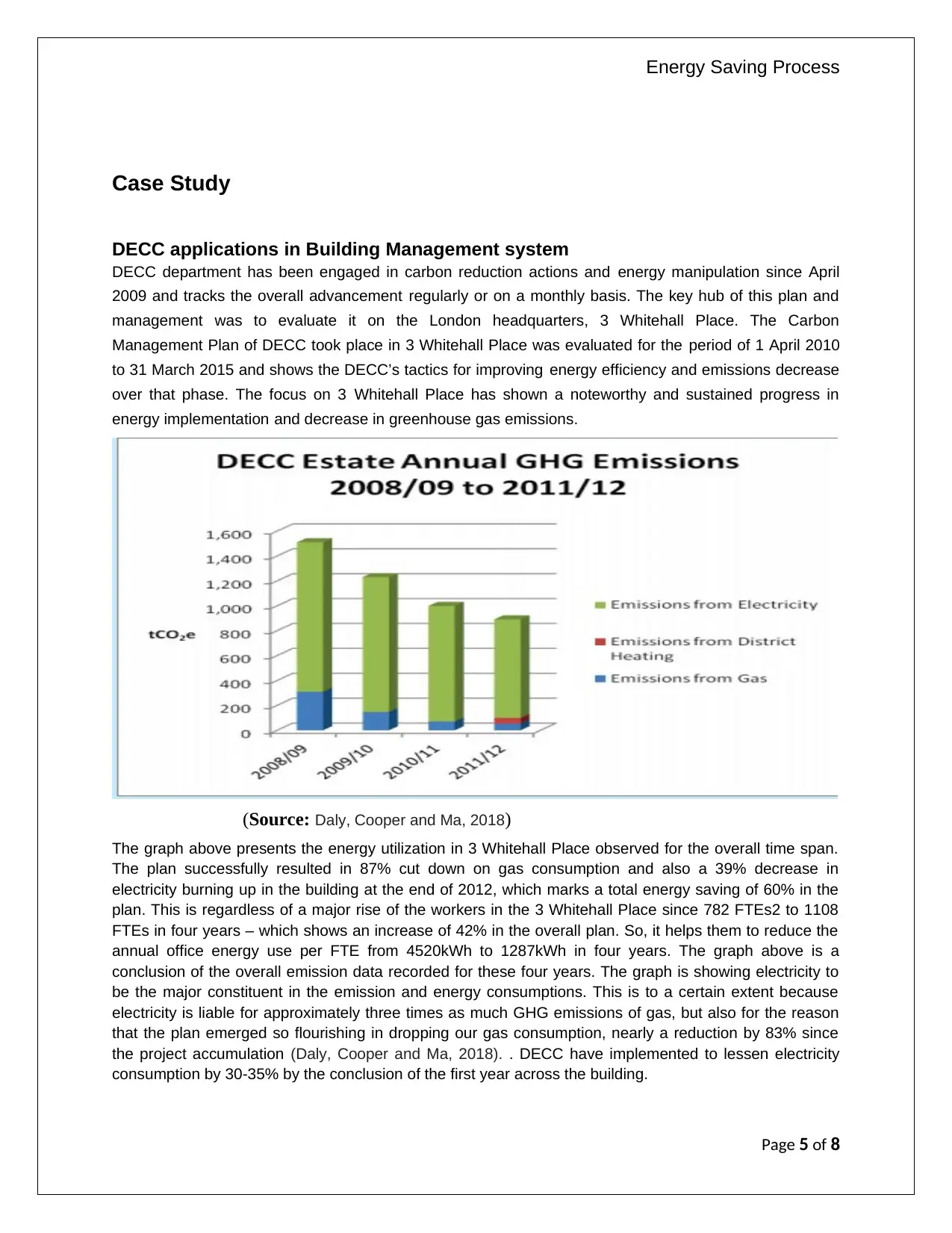
Energy Saving Process
Case Study
DECC applications in Building Management system
DECC department has been engaged in carbon reduction actions and energy manipulation since April
2009 and tracks the overall advancement regularly or on a monthly basis. The key hub of this plan and
management was to evaluate it on the London headquarters, 3 Whitehall Place. The Carbon
Management Plan of DECC took place in 3 Whitehall Place was evaluated for the period of 1 April 2010
to 31 March 2015 and shows the DECC’s tactics for improving energy efficiency and emissions decrease
over that phase. The focus on 3 Whitehall Place has shown a noteworthy and sustained progress in
energy implementation and decrease in greenhouse gas emissions.
(Source: Daly, Cooper and Ma, 2018)
The graph above presents the energy utilization in 3 Whitehall Place observed for the overall time span.
The plan successfully resulted in 87% cut down on gas consumption and also a 39% decrease in
electricity burning up in the building at the end of 2012, which marks a total energy saving of 60% in the
plan. This is regardless of a major rise of the workers in the 3 Whitehall Place since 782 FTEs2 to 1108
FTEs in four years – which shows an increase of 42% in the overall plan. So, it helps them to reduce the
annual office energy use per FTE from 4520kWh to 1287kWh in four years. The graph above is a
conclusion of the overall emission data recorded for these four years. The graph is showing electricity to
be the major constituent in the emission and energy consumptions. This is to a certain extent because
electricity is liable for approximately three times as much GHG emissions of gas, but also for the reason
that the plan emerged so flourishing in dropping our gas consumption, nearly a reduction by 83% since
the project accumulation (Daly, Cooper and Ma, 2018). . DECC have implemented to lessen electricity
consumption by 30-35% by the conclusion of the first year across the building.
Page 5 of 8
Case Study
DECC applications in Building Management system
DECC department has been engaged in carbon reduction actions and energy manipulation since April
2009 and tracks the overall advancement regularly or on a monthly basis. The key hub of this plan and
management was to evaluate it on the London headquarters, 3 Whitehall Place. The Carbon
Management Plan of DECC took place in 3 Whitehall Place was evaluated for the period of 1 April 2010
to 31 March 2015 and shows the DECC’s tactics for improving energy efficiency and emissions decrease
over that phase. The focus on 3 Whitehall Place has shown a noteworthy and sustained progress in
energy implementation and decrease in greenhouse gas emissions.
(Source: Daly, Cooper and Ma, 2018)
The graph above presents the energy utilization in 3 Whitehall Place observed for the overall time span.
The plan successfully resulted in 87% cut down on gas consumption and also a 39% decrease in
electricity burning up in the building at the end of 2012, which marks a total energy saving of 60% in the
plan. This is regardless of a major rise of the workers in the 3 Whitehall Place since 782 FTEs2 to 1108
FTEs in four years – which shows an increase of 42% in the overall plan. So, it helps them to reduce the
annual office energy use per FTE from 4520kWh to 1287kWh in four years. The graph above is a
conclusion of the overall emission data recorded for these four years. The graph is showing electricity to
be the major constituent in the emission and energy consumptions. This is to a certain extent because
electricity is liable for approximately three times as much GHG emissions of gas, but also for the reason
that the plan emerged so flourishing in dropping our gas consumption, nearly a reduction by 83% since
the project accumulation (Daly, Cooper and Ma, 2018). . DECC have implemented to lessen electricity
consumption by 30-35% by the conclusion of the first year across the building.
Page 5 of 8
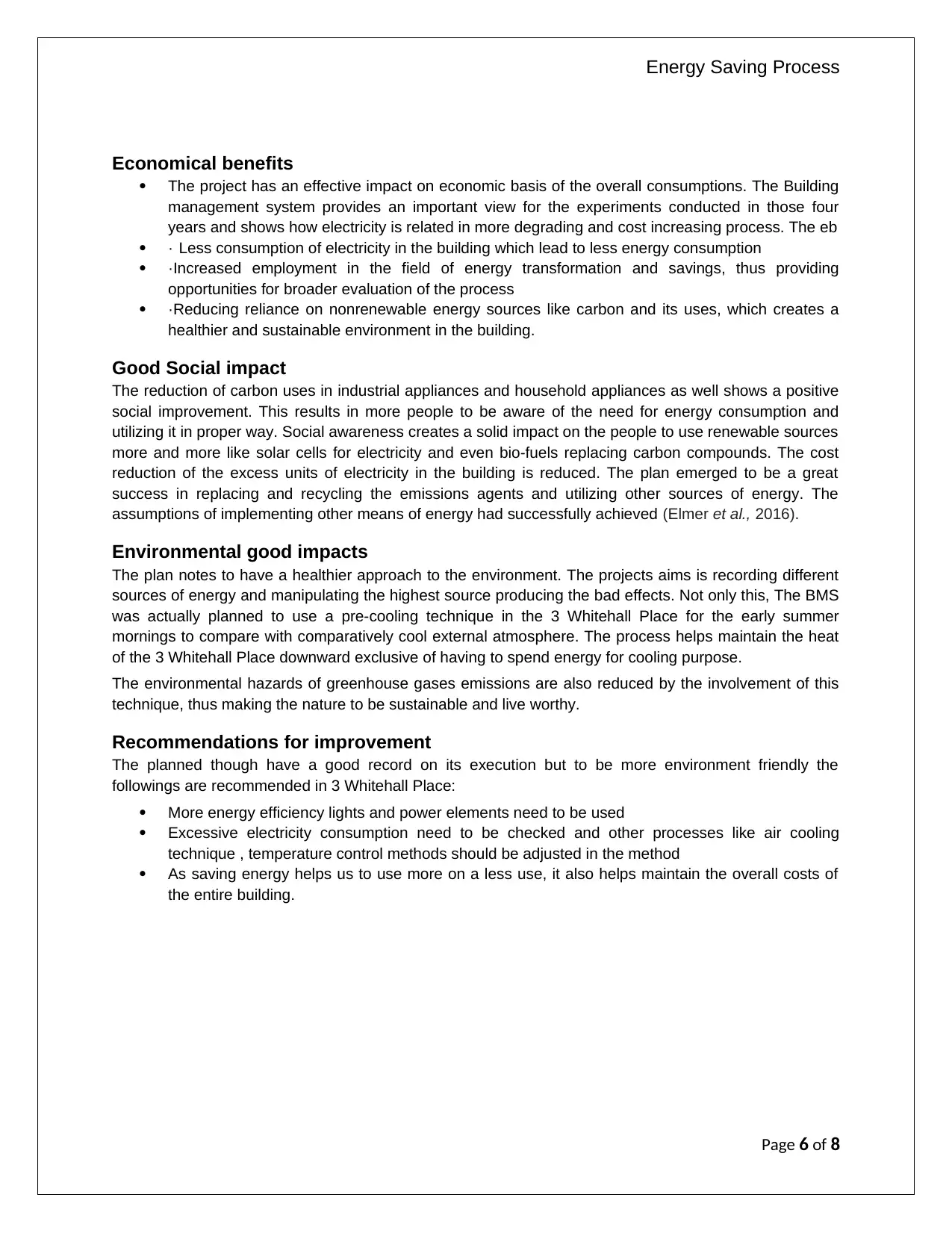
Energy Saving Process
Economical benefits
The project has an effective impact on economic basis of the overall consumptions. The Building
management system provides an important view for the experiments conducted in those four
years and shows how electricity is related in more degrading and cost increasing process. The eb
· Less consumption of electricity in the building which lead to less energy consumption
·Increased employment in the field of energy transformation and savings, thus providing
opportunities for broader evaluation of the process
·Reducing reliance on nonrenewable energy sources like carbon and its uses, which creates a
healthier and sustainable environment in the building.
Good Social impact
The reduction of carbon uses in industrial appliances and household appliances as well shows a positive
social improvement. This results in more people to be aware of the need for energy consumption and
utilizing it in proper way. Social awareness creates a solid impact on the people to use renewable sources
more and more like solar cells for electricity and even bio-fuels replacing carbon compounds. The cost
reduction of the excess units of electricity in the building is reduced. The plan emerged to be a great
success in replacing and recycling the emissions agents and utilizing other sources of energy. The
assumptions of implementing other means of energy had successfully achieved (Elmer et al., 2016).
Environmental good impacts
The plan notes to have a healthier approach to the environment. The projects aims is recording different
sources of energy and manipulating the highest source producing the bad effects. Not only this, The BMS
was actually planned to use a pre-cooling technique in the 3 Whitehall Place for the early summer
mornings to compare with comparatively cool external atmosphere. The process helps maintain the heat
of the 3 Whitehall Place downward exclusive of having to spend energy for cooling purpose.
The environmental hazards of greenhouse gases emissions are also reduced by the involvement of this
technique, thus making the nature to be sustainable and live worthy.
Recommendations for improvement
The planned though have a good record on its execution but to be more environment friendly the
followings are recommended in 3 Whitehall Place:
More energy efficiency lights and power elements need to be used
Excessive electricity consumption need to be checked and other processes like air cooling
technique , temperature control methods should be adjusted in the method
As saving energy helps us to use more on a less use, it also helps maintain the overall costs of
the entire building.
Page 6 of 8
Economical benefits
The project has an effective impact on economic basis of the overall consumptions. The Building
management system provides an important view for the experiments conducted in those four
years and shows how electricity is related in more degrading and cost increasing process. The eb
· Less consumption of electricity in the building which lead to less energy consumption
·Increased employment in the field of energy transformation and savings, thus providing
opportunities for broader evaluation of the process
·Reducing reliance on nonrenewable energy sources like carbon and its uses, which creates a
healthier and sustainable environment in the building.
Good Social impact
The reduction of carbon uses in industrial appliances and household appliances as well shows a positive
social improvement. This results in more people to be aware of the need for energy consumption and
utilizing it in proper way. Social awareness creates a solid impact on the people to use renewable sources
more and more like solar cells for electricity and even bio-fuels replacing carbon compounds. The cost
reduction of the excess units of electricity in the building is reduced. The plan emerged to be a great
success in replacing and recycling the emissions agents and utilizing other sources of energy. The
assumptions of implementing other means of energy had successfully achieved (Elmer et al., 2016).
Environmental good impacts
The plan notes to have a healthier approach to the environment. The projects aims is recording different
sources of energy and manipulating the highest source producing the bad effects. Not only this, The BMS
was actually planned to use a pre-cooling technique in the 3 Whitehall Place for the early summer
mornings to compare with comparatively cool external atmosphere. The process helps maintain the heat
of the 3 Whitehall Place downward exclusive of having to spend energy for cooling purpose.
The environmental hazards of greenhouse gases emissions are also reduced by the involvement of this
technique, thus making the nature to be sustainable and live worthy.
Recommendations for improvement
The planned though have a good record on its execution but to be more environment friendly the
followings are recommended in 3 Whitehall Place:
More energy efficiency lights and power elements need to be used
Excessive electricity consumption need to be checked and other processes like air cooling
technique , temperature control methods should be adjusted in the method
As saving energy helps us to use more on a less use, it also helps maintain the overall costs of
the entire building.
Page 6 of 8
⊘ This is a preview!⊘
Do you want full access?
Subscribe today to unlock all pages.

Trusted by 1+ million students worldwide
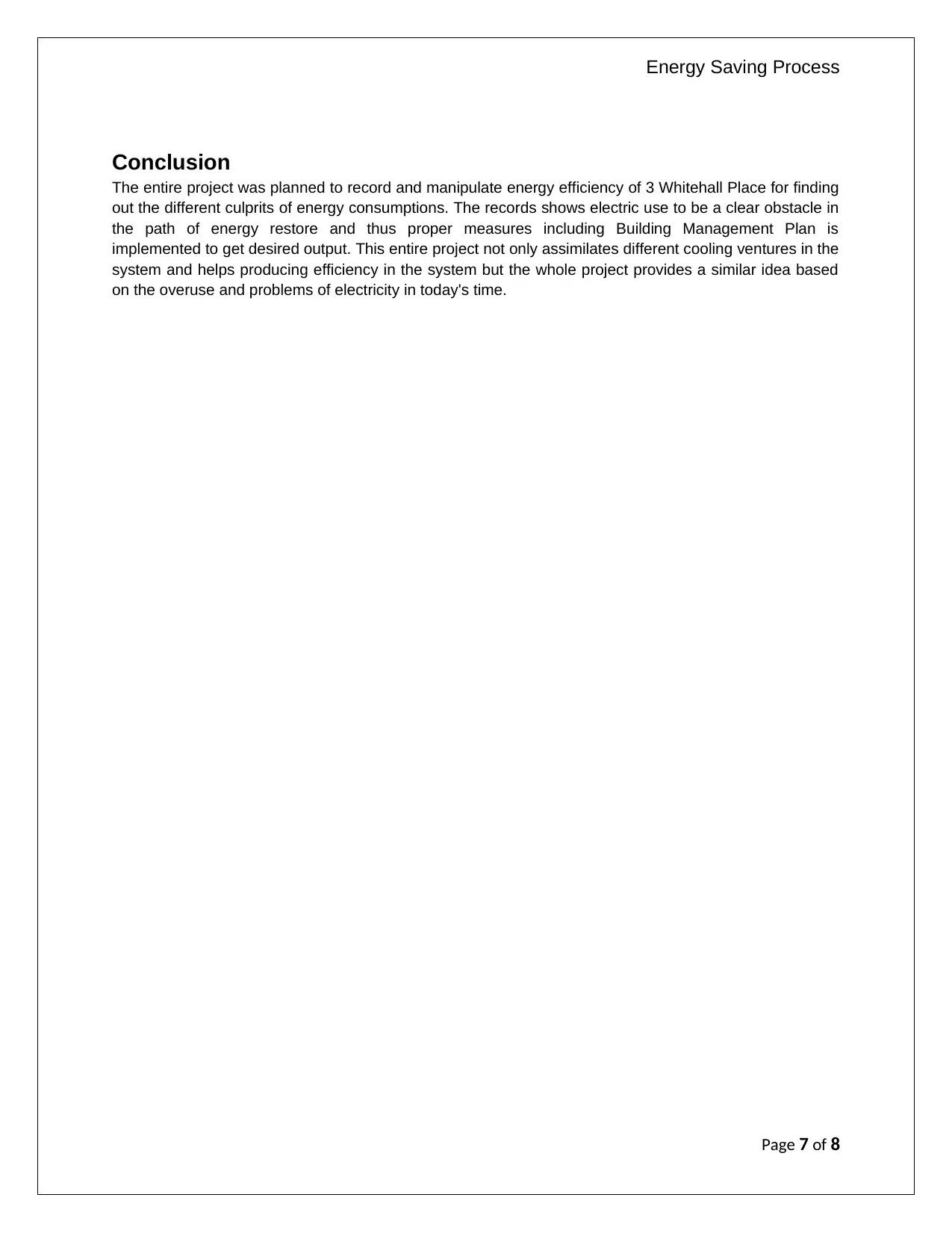
Energy Saving Process
Conclusion
The entire project was planned to record and manipulate energy efficiency of 3 Whitehall Place for finding
out the different culprits of energy consumptions. The records shows electric use to be a clear obstacle in
the path of energy restore and thus proper measures including Building Management Plan is
implemented to get desired output. This entire project not only assimilates different cooling ventures in the
system and helps producing efficiency in the system but the whole project provides a similar idea based
on the overuse and problems of electricity in today's time.
Page 7 of 8
Conclusion
The entire project was planned to record and manipulate energy efficiency of 3 Whitehall Place for finding
out the different culprits of energy consumptions. The records shows electric use to be a clear obstacle in
the path of energy restore and thus proper measures including Building Management Plan is
implemented to get desired output. This entire project not only assimilates different cooling ventures in the
system and helps producing efficiency in the system but the whole project provides a similar idea based
on the overuse and problems of electricity in today's time.
Page 7 of 8
Paraphrase This Document
Need a fresh take? Get an instant paraphrase of this document with our AI Paraphraser
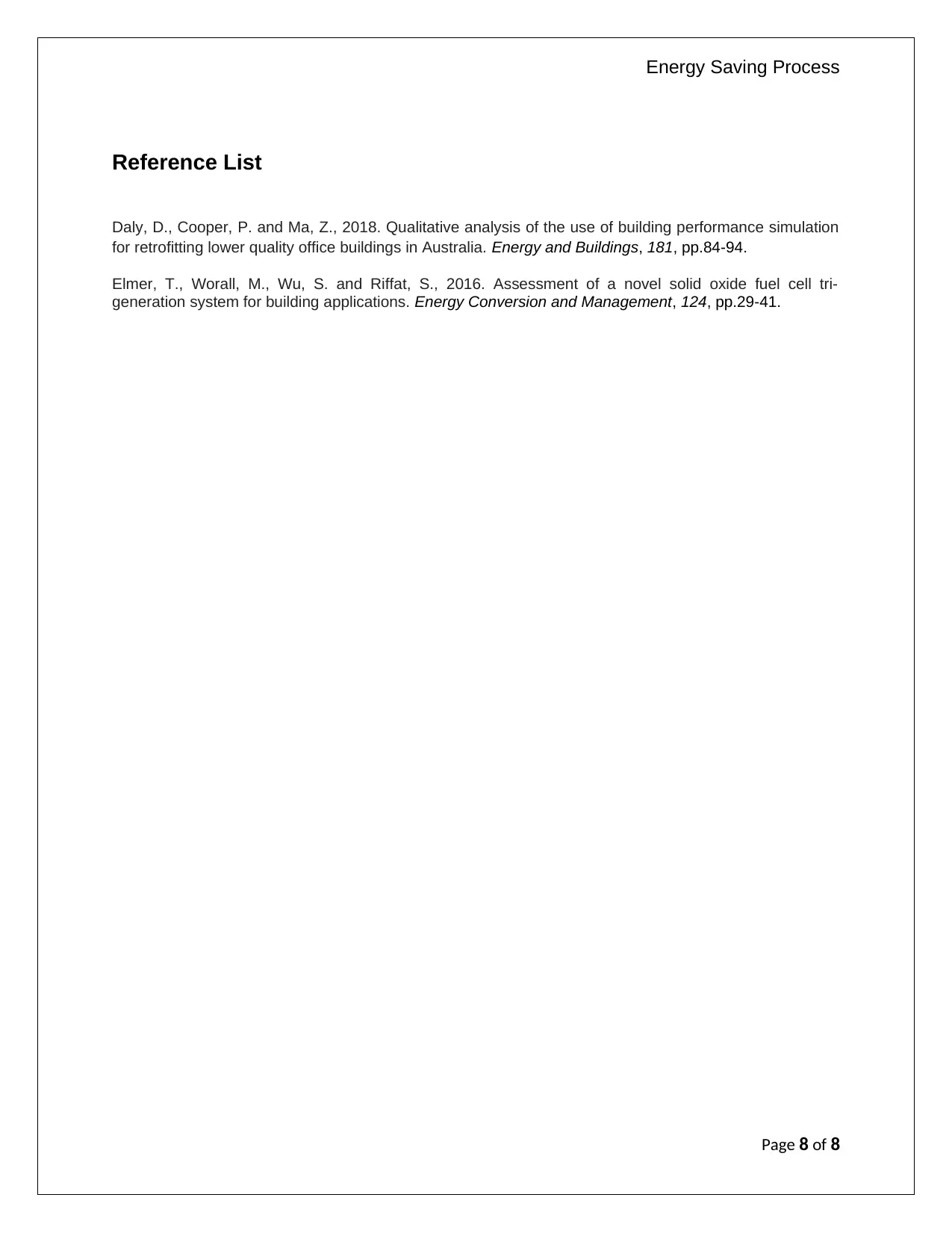
Energy Saving Process
Reference List
Daly, D., Cooper, P. and Ma, Z., 2018. Qualitative analysis of the use of building performance simulation
for retrofitting lower quality office buildings in Australia. Energy and Buildings, 181, pp.84-94.
Elmer, T., Worall, M., Wu, S. and Riffat, S., 2016. Assessment of a novel solid oxide fuel cell tri-
generation system for building applications. Energy Conversion and Management, 124, pp.29-41.
Page 8 of 8
Reference List
Daly, D., Cooper, P. and Ma, Z., 2018. Qualitative analysis of the use of building performance simulation
for retrofitting lower quality office buildings in Australia. Energy and Buildings, 181, pp.84-94.
Elmer, T., Worall, M., Wu, S. and Riffat, S., 2016. Assessment of a novel solid oxide fuel cell tri-
generation system for building applications. Energy Conversion and Management, 124, pp.29-41.
Page 8 of 8
1 out of 8
Related Documents
Your All-in-One AI-Powered Toolkit for Academic Success.
+13062052269
info@desklib.com
Available 24*7 on WhatsApp / Email
![[object Object]](/_next/static/media/star-bottom.7253800d.svg)
Unlock your academic potential
Copyright © 2020–2025 A2Z Services. All Rights Reserved. Developed and managed by ZUCOL.





